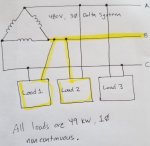julian padilla
Member
- Location
- Houston, TX, USA
Can you please show me the math for calculating the minimum standard size fuse required to protect the conductor for Phase-B in the feeder, given a 3-Phase, 3-Wire 480 V Delta (no neutral). The three line-to-line loads are 49 kW single-phase for each of the three loads (Load_1 is 49 kW Line B-C, Load_1 is 49 kW Line A-B, Load_1 is 49 kW Line A-C). Your help would be greatly appreciated.
Julian
Julian

